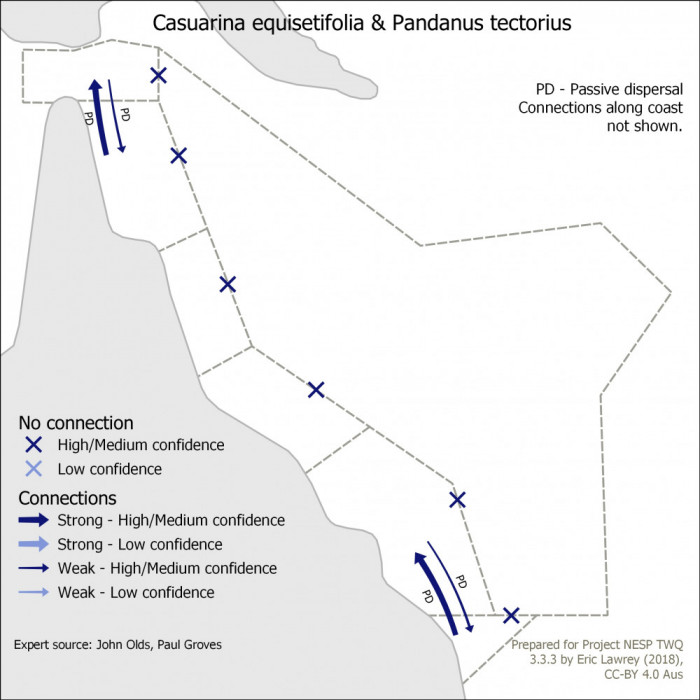Casuarina connectivity
What are Casuarina trees and why are they important?
Coastal she-oaks (Casuarina equisetifolia) are an evergreen tree (6 to 20m high) found on coastal sand dunes, beach fronts in sands alongside estuaries and behind fore-dunes, and on gentle lower hills/headlands. Other common names include beach casuarina, beach she-oak or whistling tree.
The trees have weeping needle-like jointed branchlets; slender, much-branched green to grey-green, bearing minute scale-leaves in whorls of 6–8. The wind blowing through the foliage can produce a whistling effect. Unlike most other species of Casuarina, it is monoecious, with very small separate male and female flowers produced on the same tree. Numerous rough globular woody fruiting ‘cones’ (superficially resembling a conifer cone), commonly found beneath the tree; inside the cone are the fruits which are small wafer-like single seeds. Importantly coastal she-oaks can withstand exposure and salt-spray.
Distribution: Tropical and subtropical coastlines of northern and north-eastern Australia; also from Burma to Vietnam, Malesia, Melanesia and Polynesia. There are 2 subspecies, intergrading on the Qld coast between Cooktown and Sarina; also in Vanuatu (ABRS, 1989).
The species has been introduced to the southern United States and Africa, and is considered an invasive species in Florida and South Africa (Masterson, 2007).
Coastal she-oaks are an attractive shade, shelter and windbreak tree, and valuable for coastal dune stabilisation. They may form dense stands on coastal foreshores, sometimes suckering from the roots. Their root nodules are nitrogen-fixing and add to soil fertility (Brock, 1988). They were utilised by Aboriginals for a range of uses (eg. excellent fuel wood; the wood was hard and durable and used for spears, etc; inner bark was used to treat toothache or sore mouth).
Trees are reported to tolerate calcareous soils, drought, granitic soils, poor soil, salt and salt spray, sand and waterlogging. It is, however, one of the most fire-sensitive of the Casaurina species, and is also sensitive to grazing, and, in early stages, weed competition. Older trees are a problem in cyclones, due to the shallow root system and its tendency to be blown over.
Key concepts that relate to connectivity
Under climate change, the existing beach scrub trees will be displaced and will be replaced by salt tolerant woody plants including coastal she-oak (Casuarina equisetifolia); consequently such tolerant plants are likely to expand their range along the coast and on some GBR islands (Turner and Batinoff, 2007).
Coastal she-oaks are a highly competent invader and have been known to colonize newly disturbed and nutrient-poor sites because of their high fecundity, protracted reproductive season, broadcast seed dispersal, and tendency to form monspecific stands.
On the negative side, the leaf litter suppresses germination of understorey plants as the fallen branchlets are allelopathic in nature, containing chemical compounds that inhibit growth, survival, or recolonization by native plant species (Masterson, 2007). This is one reason it can be such a damaging invasive species in places outside its native range.
Where Pisonia forest has been lost, Black noddies may nest on other trees, such as casuarinas on Lady Elliott Island (B Knuckey, pers comm), but their nesting success may be reduced.
References
ABRS (1989) "Casuarina equisetifolia L., Amoen. Acad. 143 (1759)". Data derived from Flora of Australia Volume 3 (1989), a product of Australian Biological Resources Study. Australian National Botanic Gardens. © Commonwealth of Australia
Brock, John (1988). Top End Native Plants. Self-published. ISBN 0 7316 0859 3
Duke, JA (1983). Casuarina equisetifolia J.R. & G. Forst. Handbook of Energy Crops. https://hort.purdue.edu/newcrop/duke_energy/Casuarina_equisetifolia.html. Retrieved 7 March 2018.
Masterson, J (2007) Indian River Lagoon Species Inventory. Fort Pierce: Smithsonian Marine Station. http://www.sms.si.edu/irlspec/Casuarina_equisetifolia.htm Retrieved 7 March 2018.
Turner, M and Batianoff, GN (2007). Chapter 20, Vulnerability of island flora and fauna in the Great Barrier Reef to climate change. In Climate Change and the Great Barrier Reef, eds. Johnson JE and Marshall PA. GBRMPA and Australian Greenhouse Office, Australia




